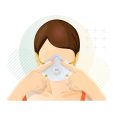Understanding Dry Skin and Dehydrated Skin
When it comes to skincare, knowing the difference between dry skin and dehydrated skin is critical for choosing the right products and routines. Although these terms are often used interchangeably, they actually refer to two distinct skin concerns with unique characteristics. Dry skin is a skin type that lacks oil or sebum, making it inherently rough, flaky, and sometimes itchy year-round. On the other hand, dehydrated skin is a temporary condition where the skin lacks water, not oil. This means even oily or combination skin types can experience dehydration. While dry skin feels persistently tight and may show visible cracks or rough patches, dehydrated skin often looks dull, feels tight only at certain times, and may be prone to increased sensitivity or fine lines. Understanding these differences is essential because treating dry skin requires replenishing lost oils, whereas dehydrated skin needs hydration to restore its water balance. Recognizing your skin’s specific needs is the first step toward a healthier, more resilient complexion.
2. Causes of Dry Skin vs Dehydrated Skin
Understanding the causes behind dry skin and dehydrated skin is crucial for choosing the right skincare strategy, especially within the unique climate and lifestyle found in the United States. While both conditions may feel similar, their origins are quite different: dry skin stems from a lack of natural oils (sebum), while dehydrated skin results from insufficient water content. Let’s break down the internal and external factors that contribute to each type.
Internal vs. External Factors
| Dry Skin (Lack of Oil) | Dehydrated Skin (Lack of Water) | |
|---|---|---|
| Internal Factors |
|
|
| External Factors |
|
|
The American Climate Impact
The U.S. features a variety of climates, from humid coastal cities like Miami to dry desert regions such as Las Vegas. In the Northeast and Midwest, winter heating systems can zap indoor humidity, exacerbating both dryness and dehydration. Meanwhile, West Coast sun lovers may experience more water loss due to UV exposure. Understanding your local climate—and how it interacts with your daily habits—can help you pinpoint whether your skin needs more oil, more water, or both.
Lifestyle Considerations Unique to America
American lifestyles often feature long workdays inside climate-controlled offices, frequent travel across time zones (which can disrupt hydration), and popular beauty trends like retinoids or chemical exfoliants. These factors can strip away protective oils or further dehydrate the skin if not balanced with proper hydration practices.
Key Takeaway:
Pinpointing whether your skin is dry or dehydrated starts by evaluating your environment and habits. Addressing both internal (diet, genetics) and external (weather, products) triggers is essential for building an effective skincare routine tailored to life in America.

3. How to Tell the Difference
Confused about whether you have dry skin or dehydrated skin? You’re not alone. Many people mix up these terms, but understanding the difference is key to finding the right skincare solutions. Here are practical tips and real-life scenarios that will help you accurately identify your skin’s needs.
Check Your Skin’s Texture and Feel
Dry skin is a skin type, usually feeling rough, flaky, or even itchy all year round, regardless of external factors. It often appears dull and can be sensitive. If your skin feels tight even after applying moisturizer and you notice persistent flakiness, chances are you have dry skin.
Dehydrated skin, on the other hand, is a temporary condition caused by a lack of water—not oil. This means your skin may feel tight and look shiny at the same time, or you might notice fine lines appearing suddenly (especially after washing your face). Dehydrated skin can affect anyone, even those with oily or combination skin types.
Real-Life Scenarios
- You apply moisturizer but still feel flaky: Likely dry skin—your skin lacks oil and needs richer creams or balms.
- Your makeup cakes around fine lines by midday: Classic sign of dehydration—your skin is thirsty for water-based hydration like serums with hyaluronic acid.
- Your T-zone is oily but cheeks are tight: Indicates dehydrated skin, especially common during seasonal changes or after harsh skincare treatments.
- Your skin gets worse in winter but normalizes in summer: Suggests dry skin, as cold air strips away natural oils more aggressively.
Common Misconceptions
- “My skin is oily, so it can’t be dehydrated.” False! Even oily skin can lack water and feel tight or uncomfortable.
- “Dryness always means flaking.” Not necessarily—dehydrated skin often looks smooth but feels uncomfortably tight and shows exaggerated expression lines.
Pro Tip: The Pinch Test
Gently pinch your cheek. If it wrinkles easily instead of bouncing back, your skin might be dehydrated. If it feels rough or scaly without much elasticity loss, it’s probably dry.
By paying close attention to how your skin behaves—and not just how it looks—you’ll be able to choose products that actually work for your unique situation. Proper identification is the first step towards healthier, happier skin.
4. How to Treat Dry Skin
If you have dry skin, it’s crucial to adopt a targeted approach supported by dermatologists and tailored to the American lifestyle. Here’s how you can effectively address dry skin with best practices, proven ingredients, and smart daily habits.
Best Practices for Managing Dry Skin
- Limit Hot Showers: Use lukewarm water instead of hot, as hot water strips natural oils from your skin.
- Moisturize Immediately: Apply moisturizer within three minutes after bathing to lock in moisture.
- Use Gentle Cleansers: Choose fragrance-free, non-foaming cleansers to avoid irritation and further dryness.
- Humidify Your Space: Especially in winter or arid climates, use a humidifier to add moisture back into the air at home.
Dermatologist-Recommended Ingredients
| Ingredient | How It Helps | Common Product Types |
|---|---|---|
| Ceramides | Replenish and restore the skin barrier | Creams, lotions |
| Hyaluronic Acid | Binds water to skin for deep hydration | Serums, moisturizers |
| Glycerin | Draws moisture into the outer layer of skin | Cleansers, creams |
| Squalane | Mimics natural oils for long-lasting softness | Oils, moisturizers |
| Colloidal Oatmeal | Soothes itching and inflammation | Creams, bath soaks |
Lifestyle Habits for Healthier Skin
- Avoid Over-Exfoliating: Limit physical or chemical exfoliation to once a week to prevent aggravating dryness.
- Dress Smart: In colder U.S. regions, wear gloves and scarves to protect exposed skin from harsh winds.
- Hydrate Well: Drink plenty of water throughout the day—hydration starts from within.
- Choose Laundry Detergents Wisely: Opt for fragrance-free and dye-free detergents to minimize irritation from clothing.
- Sunscreen Is Still Essential: Even if you’re prone to dryness, always use a broad-spectrum SPF 30+ year-round.
Your Action Plan: Daily Dry Skin Care Routine (Sample)
| Step | Description |
|---|---|
| Morning Cleanse | Mild, hydrating cleanser; pat dry with a soft towel. |
| Treatment Serum | Apply hyaluronic acid serum while skin is damp. |
| Main Moisturizer | Ceramide-rich cream or lotion; focus on driest areas. |
| Sunscreen Protection | Broad-spectrum SPF 30+ as final step before heading out. |
| Evening Nourishment | Cleansing followed by a thicker night cream or facial oil (like squalane). |
If Symptoms Persist…
If your dry skin continues despite these measures, consult a board-certified dermatologist. Persistent dryness could signal underlying conditions like eczema or psoriasis that require specialized care. Adopting these expert-backed strategies will help keep your skin comfortable and resilient in any American climate or season.
5. How to Treat Dehydrated Skin
Effective Strategies for Restoring Hydration
Dehydrated skin is a temporary condition that can be reversed by replenishing moisture and preventing further water loss. The key is to focus on both topical hydration and lifestyle adjustments. Start with a gentle, hydrating cleanser that won’t strip your skin’s natural barrier. Avoid harsh scrubs or foaming cleansers; instead, opt for formulas containing ingredients like glycerin or hyaluronic acid.
Top Product Recommendations
In the U.S., it’s easy to access over-the-counter products tailored for dehydrated skin. Look for serums and moisturizers containing hyaluronic acid (like Neutrogena Hydro Boost Water Gel), glycerin (CeraVe Hydrating Facial Cleanser), or aloe vera. Layering is key: apply a hydrating serum first, followed by a lightweight, non-comedogenic moisturizer to lock in moisture. For an extra boost, consider overnight hydrating masks such as Laneige Water Sleeping Mask, which are widely available at U.S. retailers like Sephora and Target.
Lifestyle Changes for Long-Term Results
Hydration isn’t just about what you put on your skin—it’s also about how you live. Make sure you’re drinking enough water throughout the day (the CDC recommends around 8 cups daily as a general guideline). Limit caffeine and alcohol, which can contribute to dehydration. Use a humidifier during dry winter months or if you live in arid regions of the U.S., as indoor heating and air conditioning sap moisture from the air and your skin. Finally, avoid long, hot showers, as these can strip your skin of essential moisture.
Pro Tips for Busy American Lifestyles
If you’re always on the go, keep a travel-sized facial mist (such as Evian Mineral Water Spray) in your bag for quick hydration boosts throughout the day—perfect for office workers or frequent flyers. Prioritize sunscreen daily, as UV exposure can worsen dehydration; choose formulas labeled “hydrating” or “moisturizing” (like La Roche-Posay Anthelios Melt-in Milk Sunscreen).
By combining smart product choices with mindful lifestyle habits tailored to common American routines, you’ll restore your skin’s hydration and maintain its healthy glow year-round.
6. When to Seek Professional Help
While most cases of dry or dehydrated skin can be managed with over-the-counter products and lifestyle changes, there are certain warning signs that should prompt you to consult a dermatologist or healthcare provider. In the United States, it’s common to start with a primary care physician or directly schedule an appointment with a board-certified dermatologist.
Red Flags That Require Medical Attention
- Persistent Symptoms: If your skin remains excessively dry, flaky, itchy, or tight for several weeks despite using moisturizers and proper hydration strategies, it may indicate an underlying health condition such as eczema, psoriasis, or thyroid disorders.
- Severe Itching or Discomfort: Intense itching, burning sensations, or pain could signal an infection or allergic reaction. Open cracks or sores that don’t heal are also concerning.
- Sudden Changes: Rapid onset of dryness, peeling, redness, swelling, or blisters may suggest a more serious dermatological issue that requires professional assessment.
- Signs of Infection: Look for symptoms like pus, yellow crusting, increased warmth in the area, or fever. These indicate bacterial involvement and need prompt treatment in a U.S. healthcare setting.
Circumstances Unique to U.S. Readers
- Medication Side Effects: Certain medications commonly prescribed in the U.S.—like retinoids, diuretics, or cholesterol-lowering drugs—can exacerbate dry skin. Discuss any skin changes with your prescribing doctor.
- Climate Factors: If you live in regions with harsh winters (Northeast, Midwest) or arid environments (Southwest), chronic dryness might require personalized skincare advice from a local professional familiar with regional challenges.
How to Find the Right Professional
If you experience any of the warning signs above, search for “dermatologist near me” on reputable platforms like the American Academy of Dermatology Association (AAD.org). Many U.S. insurance plans cover dermatologist visits when medically necessary—check your plan details for referrals and co-pays. Early intervention can prevent complications and help restore your skin’s health efficiently.


